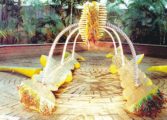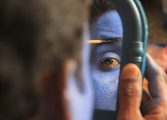In her book, Not for Profit: Why Democracy Needs the Humanities (2010), Nussbaum, a distinguished scholar and philosopher at the University of Chicago, announces a crisis in education of unprecedented proportions world-over. This crisis, she maintains, unlike the economic crisis of 2008, “goes largely unnoticed, like a cancer; a crisis that is likely to be, in the long run, far more damaging to the future of democratic self-government: a worldwide crisis in education.” [15] What, according to Nussbaum, is the nature of the crisis?
Nussbaum’s analysis of the problem turns around the distinction she sets up between two contrasting models of education: A model of education for economic growth versus a model of education for democracy. The former model that focuses on skills associated with science and technology and aims at economic growth and profit is increasingly being adopted by many nations in response to the economic pressures of globalization. Since humanities, the study of history, languages, philosophy, literature and art, do not in any direct ways address our economic needs, these disciplines, she argues, face acute fund cuts and tend to be neglected. The growing emphasis on the economic model of education, Nussbaum cautions, has serious influence consequences on the education of the next generation of learners. It is corrosive of our democratic culture for it restricts the development of complete, creative citizens who can think independently for themselves. Instead, Nussbaum defends the idea of education for democratic citizenship or what she refers to as the “human development paradigm” that aims at the complete development of individual human capacities that are conducive to a healthy democratic society.
In the rest of the book, Nussbaum’s concern is to flesh out what education for democracy entails, the ideas of the philosophers who have helped flesh out its core values at various historical moments, the methods and content such a model must adopt. While acknowledging cursorily that education is more than for citizenship, Nussbaum argues that a healthy democracy requires creative, independent thinkers who do not succumb to the power of authority, hierarchies or tradition. Young people must be prepared for making informed, reasoned choices on crucial issues and be encouraged to cultivate the ability to discuss with people belonging to different cultures, ethnicities, gender and religions. The best mode of producing such individuals is to nurture the Socratic method of dialogue which encourages critical thinking. The critical thinking ability, for Nussbaum, are best cultivated not by a narrow, exclusive focus on science, math and technological skills (though she is careful not to exclude these) but by the humanities and the arts which concern themselves with lives of others from different class, race, gender, nationality and culture. It thus enables critical reflection, helps cultivate one’s sensibility, emotions and empathetic understanding of lives other than one’s own, thereby producing “global citizens.” It is precisely these disciplines for her that foster critical and imaginative thinking that are under threat due to a market-driven approach to education.
These concerns also run through and are elaborated in greater detail in her earlier book Cultivating Humanity: A Classical Defense of Reform in Liberal Education (1997). Once again, central to Nussbaum’s understanding of liberal education is critical thinking, which often takes the form of an emphasis on critical reason and its antithetical relationship to tradition. The tension between them, for Nussbaum, is at the heart of liberal education. If in Not for Profit, education for democratic citizenship is contrasted with a model of education that focuses on economic growth, in Cultivating Humanity, Nussbaum distinguishes between two conceptions of (liberal) education that our culture is torn between: an “old” idea of education that is liberalis (fitted for freedom) in the sense that it is aimed at initiating the elite or freeborn gentlemen of propertied classes into long-established and revered traditions of their own society, encouraging loyalty and adherence to their intellectual tradition while discouraging critical questioning, and a “new” education represented by Seneca which is liberalis because it produces those “fitted for freedom” not because of birth or wealth but because they are free citizens, who can call “their minds their own.” They are free citizens who have developed the ability to separate habits and traditions from what they can defend by reason and argument. They have cultivated the capacity to think critically about seemingly timeless moral norms and on one’s own without fear of authority, an ideal more conducive to a democratic society:
When we ask about the relationship of a liberal education to citizenship, we are asking a question with a long history in the Western philosophical tradition. We are drawing on Socrates’ concept of “the examined life,” on Aristotle’s notions of reflective citizenship, and above all on Greek and Roman Stoic notions of an education that is “liberal” in that it liberates the mind from the bondage of habit and custom, producing people who can function with sensitivity and alertness as citizens of the whole world. This is what Seneca means by the cultivation of humanity. The idea of the well-educated person as a “citizen of the world” has had a formative influence on Western thought about education: on David Hume and Adam Smith in the Scottish/English tradition, on Immanuel Kant in the continental Enlightenment tradition, on Thomas Paine and other Founding Fathers in the American tradition. Understanding the classical roots of these ideas helps us recover powerful arguments that have exercised a formative influence on our democracy.[16]
Defining “liberal” in liberal education as that which “frees the mind from bondages of custom and habit,” Nussbaum elaborates on the three capacities which she sees as essential to the cultivation of humanity for contemporary times: a) the Socratic ability to question and justify our beliefs, with the capacity for critical examination of oneself and one’s tradition b) the ability to rise beyond local loyalties, see oneself as part of a diverse, heterogeneous world and address the problems of the world as “world citizens” c) narrative imagination and the ability to empathize with others.
Nussbaum’s fervent appeal for a liberal arts programme is evident in both books and so is her attempt at envisaging a purpose for higher education which is for more than economic reasons or for creating a specialist/expert in technological skills or some other form of narrow specialization. What this “more than” consists of is expressed in her notion of education where the humanities have commitment to producing world-citizens, who have cultivated the attitude of “critical reasoning,” and the necessary narrative imagination that helps them function as sensitive, sympathetic citizens who recognize shared vulnerabilities and capacities for achievement even in those very different from themselves. Her conception of philosophy as the cultivation and development of each person’s practical reason (as opposed to Bloom’s focus on theoretical contemplation), a universal human possession and her commitment to social equality makes her argue for extending the benefits of such an education to all citizens irrespective of their culture, race, gender and sexuality. To insist on the equal worth of all human beings, she admits, is a radical social agenda but “it is the only one worthy of our conception of democracy”[17] and the humanities must remain committed to it.
Clearly, unlike Bloom, Nussbaum is more sympathetic with the multiculturalists and sees a greater role for culture in the “new” idea of liberal education she puts forth. However, she is keen to distinguish her world-citizen version of multiculturalism (which she uses to “refer to the appropriate recognition of human diversity and cultural complexity”)[18] from identity politics which, according to her, has produced an anti-humanist stance by uncritically celebrating difference while denying the presence of any common interests and conceptions, thereby restricting people to their local, parochial loyalties. Nussbaum, instead, builds her theory based on Aristotelian ideas of human flourishing and good life and argues that there are commonly shared human capabilities that constitute the notion of human being across cultures. Tracing multiculturalism back to ancient Greek and Rome, Nussbaum elaborates on the Greek image of Kosmopolites, or world-citizens who dwell in two communities simultaneously – “the local community of birth, and the community of human aspiration and argument,”[19] with a greater commitment to the latter – an idea that went onto to become highly influential in the Western tradition. Thus her claim is that cross-cultural inquiry did play an important role in the Greek idea of education (and here she differs from Bloom) because it encouraged active enquiry and ability to contrast alternatives, in the search for best possible life. The stoics in particular, she points out, made the concept of Kosmou Polites or “world-citizens” the central aspect of their educational programme.
Thus, Nussbaum’s “new” liberal education is therefore not only committed to Socratic inquiry but also to diversity and is therefore necessarily pluralistic. In this, Nussbaum also distinguishes her position from the defenders of traditional liberal education (defined by the older idea of gentleman’s education and defended in her own times by Allan Bloom, George Will and Roger Kimball) who encouraged the initiation into what was great in one’s own traditions (in this case the Western tradition) while resisting the idea that we should enlarge our perception of what it is to be human through an engagement with other cultures that were earlier regarded as unequal.
Nussbaum does not hold that there is a metaphysical truth which reveals the nature of things-in-themselves, independent of the conceptual background but her claim is that the shared capabilities and the notion of a human being are a result of cross-cultural comparison conducted over decades and have been arrived at through critical reasoning and by taking into account the various cultural differences.
However, let us take the first capability that she has listed out: the Socratic ability to question and justify our beliefs, with the capacity for critical examination of oneself and one’s tradition. In emphasizing the notion of self-examination of oneself and one’s traditions as essential to the “new” idea of liberal education, Nussbaum seems to presuppose what is distinctively an Occidental value. For instance, John Searle, in his characteristically simple, breezy and insightful defence of traditional liberal education, confesses: “I do not know any intellectual tradition that is as savagely self-critical as the Western tradition. Its hero is Socrates, and of course we all know what happened to him. “I would rather die by the present argument than live by any other,” he said. This is the model that we hold up to our students: the lone individual, standing out against the hypocrisy, stupidity, and dishonesty of the larger community.”[20] Anybody who is familiar with some of dominant protagonists of the Western canon, particularly of its novels, where the protagonist plumbs into the depths of his conscience for a process of self-examination to find his/her “true” identity through a process of disclosure,[21] will immediately know what Searle means. On the other hand, Indian society is often perceived as traditional and is known to discourage an emphasis on individuality. To say this is not to subscribe to the view that cultures like ours do not reflect, of which we have ample evidence. However, reflection, unlike the activity of self-examination, can proceed without a reference to the truth or falsity of beliefs and in fact may even proceed without invoking the notion of belief. It is the criteria of rightness or wrongness of action that is central to reflection. Rightness or wrongness is determined by “fitness to practice,” the fabric within which the an action is performed, one’s purposes and goals and has the added advantage of covering a range of practices beyond theory-making and descriptions to include non-propositional forms – literary and artistic works, performative forms, verbal and non-verbal. While Nussbaum does include literary forms for development of sensibility, the agenda of social justice and exploring the “truth” of various forms of identities takes over. As a result her reading of literary texts rests too heavily on the political goal of humanities rather than attribute to them a distinct knowledge function, thereby making them vulnerable to appropriation by various factions – left, right and centre.
While Nussbaum does “save appearances” in a sort of Aristotelian fashion, by emphasizing an empirical dimension to the study of other cultures, it is less clear in what sense cross-cultural encounter or enquiry, as she envisages it, is educative. One benefit she reiterates in several ways is that it helps cultivate a sense of detachment from uncritical allegiance to one’s own culture and fosters “a willingness to doubt the goodness of one’s own way.” By causing us to reflect on what we consider “natural” about one’s own culture, literature, history, language, we learn to extend our loyalties more broadly, across multiple groups, emerging as “citizens of the world.” However, in her examples from contemporary America, it is clear that when there is a conflict between a particular loyalty and a universal one, Nussbaum almost always expects the particular loyalty to give way to the universal. This is an outcome of the contradiction in her own theory which we can formulate as consisting of two propositions a) We must recognize and explore cultural difference b) However, while exploring cultural differences, we must arrive at common interests and understandings. The second proposition, we see, contradicts the first and in fact underwrites and erases the differences. It is like stating we must study differences in order to find out what is common to all of us so that we recognize we are all part of the same humanity. However, it is not clear why we should only look for common understandings. After all, it is in understanding differences that we should be interested in, if we wish to enlarge one’s perspective of what it is to be human and make available alternatives other than what we are familiar with. Or perhaps we will discover there is not much in common? Does not having much in common necessarily result in incommensurability? And what if there is indeed incommensurability in our interactions with certain cultures? In any case, whether there is or there is not can emerge only during or after the exploration of diverse cultures and not before.
The contradiction in the two central propositions of Nussbaum’s theory therefore ensures that we look for variants of Western notions (as her discussion and examples in her books amply illustrate) – notions of rights, privacy, individualism, equality – and to see what forms of these, when these concepts are minimally understood, are present in another culture in order to show that these concepts are of universal concern, irrespective of the culture. Or to take another of her examples, exploring how two different cultures have pursued the idea of “examined” life or addressed some other common problem. Or where she urges the cultivation of understanding about other cultures through a study of their history, religion, language, literature and culture. Such a method risks reducing the non-Western cultures to the variant of the West for all its sophistication, and sees cultures largely as a set of propositions or belief systems. While an evaluative enquiry which will help us decide which notion of good life is the best and a willingness to doubt the goodness of one’s own way is considered as desirable, Nussbaum’s own account, despite her greater acceptance of the role of cross-cultural inquiry in her idea of “new” liberal education, displays little of this spirit. A certain blindness to differing notions of good life, which may have a different criterion of evaluation than what she presupposes or upholds prevails. In all the examples she gives, almost none give us a sense of real conflict where the concepts she presupposes are rendered fragile requiring philosophical labour to work out. As a result, we still do not yet have a way of capturing the nature of the difference or we still do not have a grasp of what is it to genuinely know a tradition that is different from the Western. In other words, what is distinct about a culture fails to emerge. Cultural inequalities, it must be remembered, cannot be an argument or evidence for cultural difference.
Another educational benefit of cross-cultural inquiry that Nussbaum describes is that it helps cultivate respect and compassion for people from other cultures. While these are no doubt laudable sentiments, this must rest on an understanding of their contributions as achievements which are worth securing for the whole world, even if or perhaps because it presents a variety of human experience that is different, enriching and worthwhile to be passed on. Nussbaum’s accounts of cross-cultural experience that she details in her books rarely give one such a sense and one seldom finds her exploring any cultural conflict or tension with any philosophical depth. This perhaps is due to the fact that Nussbaum’s concern is how to interact with and accommodate diverse cultural groups which have come to constitute contemporary American life and not to understand another tradition/ culture different from her own. The question evades her due to her philosophically impoverished understanding of traditions where traditions are seen as accumulation of practices that cannot be defended by argument and reason. Thus her argument often resorts to the platitude of critical thinking as directed against one’s given customs and traditions rather than understand traditions as sites of learning which are constitutive of our notions of good life, of which our institutions of higher learning may be lofty expressions.
Nussbaum’s frequent reference to critical thinking as a mode of thinking directed against tradition is reminiscent of Enlightenment’s conceptualization of tradition as the opposite of the freedom and self-determination made possible by reason. Here, it is worthwhile to recall Gadamer’s correction that to constitute traditions and reason as opposites is an intellectual fallacy for all reasoning happens within traditions. To think of traditions as constantly to be subject to the scrutiny of reason is to fail to see traditions as an act of preservation. An act of preservation and cultivation of tradition is thus an integral part of human endeavour and is, as Gadamer points out, an act of reason (even if unarticulated) and therefore contains within it an element of freedom.[22] While Nussbaum’s own argument frequently relies on liberal traditions of thought that draw from the Greek and Enlightenment period, including reiterating the role of traditional canonical texts in liberal education and recognizing traditions as necessary nourishment for thought, Nussbaum’s philosophical understanding of tradition is less sensitive to the complex role played by tradition in a liberal education or in our lives and this contradiction strikes us at many points.






Leave a Reply
You must be logged in to post a comment.